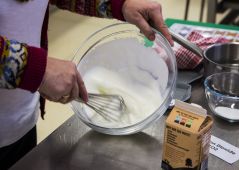Protein: foam formation

A foam forms when small bubbles of gas are trapped in a solid or liquid.
How is a foam produced?
A foam is produced by trapping millions of tiny gas bubbles in a liquid (whipped egg white) or a solid (marshmallow). Whisking water and air produces hundreds of bubbles but they soon ‘pop’, leaving only water and air again. Whisking egg white, which contains large molecules called proteins, together with air produces a much more stable foam. As the air is whipped into the egg white, tiny air pockets are captured in the mixture, each surrounded by a very thin layer of egg protein. Some of these protein molecules have hydrophilic (water-loving) and hydrophobic (water-hating) ends. The whisking process stretches out and unravels the proteins and they end up lining up because the hydrophilic ends are attracted to water in the egg white and the hydrophobic ends are repelled and attracted to the air in the pockets. Eventually the protein coating of the air pockets link together, making a foam. When an egg white foam is heated, the protein coagulates and water evaporates, forming a solid foam, in this case called a meringue.
Explore
- Place 1 egg white into a very clean bowl and time with a stop watch how long it takes to reach the stiff peak stage using a medium-low setting on an electric whisk
- Repeat the exercise, again using a very clean bowl, but this time add a drop or two of oil to the egg white before timing how long it takes to reach stiff peaks
You should find that the oil prevents the foam from forming. Why do you think that happens?


